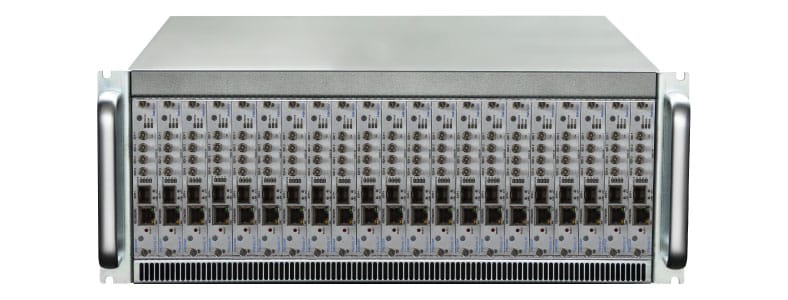Live video encoding
High density encoding, being able to process multiple live videos streams from one place, is critical for live broadcast television workflows. Just as a restaurant chef needs to have several burners fired up at once, live television producers require access to several video sources at the same time. It’s the real-time switching between cameras that makes the live experience so thrilling.
Very large sporting events, such as the Super Bowl or World Cup, will use over a hundred live camera feeds from both on and off the field, to capture every possible angle. Other types of events such as live news conferences also depend on multiple cameras and video feeds to relay as much information as possible to the end viewer. By scanning across all sides of a venue and instantly focusing on specific subjects, live television can often resemble and even be superior to attending in person.
To REMI or not to REMI
One of the exciting aspects of live television is witnessing events broadcast from afar. You might not be able to travel halfway across the world to follow your favorite team or want to stand outside in the freezing cold to take part in a ski jump competition – watching from the comfort of your own home is the next best thing. In some cases it’s even better than being in person.
The challenge for broadcasters is how to best cover live events. The classic scenario would be to bring the entire production studio to the venue by building out a temporary facility or having a fleet of OB vans ready to go. This approach is very costly and not always ideal, especially when covering events that may take place in more than one location at once.
This is where remote production workflows serve well. A remote integration (REMI) or at-home approach offers many advantages for television producers as key staff and equipment can remain at their central location. Though savings in costs and logistical planning can be significant, the more camera feeds are involved, the more bandwidth is required.
Another consideration for remote production is the logistics of transporting production equipment. If going down the REMI path, is it possible for a small team or even a single individual to manage? When capturing feeds from multiple cameras, can this be done within the confines of a small vehicle or on-site production area?
High density, high efficiency, high reliability
For remote production and REMI workflows over an IP network, it’s important to be able to simultaneously encode and stream all video feeds without hitting up against bandwidth limitations. For unpredictable networks, especially the internet, a bit of wiggle room also needs to be reserved, in case packets are lost or bandwidth fluctuates.
One way to improve bandwidth efficiency is by replacing H.264 encoding with HEVC encoding. HEVC offers greater compression efficiency, up to 50%, at similar picture quality as H.264. This means a near doubling of video streams over the same IP network.
For REMI workflows relying on the public internet, the challenge remains how to address fluctuating bandwidth and packet loss. SRT, the open-source first mile streaming protocol, can mitigate unpredictability by retransmitting lost packets when needed, and adapting the compression levels of certain video encoders, including Haivision’s Makito X and Makito X4, to adjust to available bandwidth in real-time. SRT also manages to keep latency at a minimum by employing the ARQ error correction method, whereas other methods like FEC can introduce significant latency. There is some additional overhead, but this can be more than made up for by encoding in HEVC instead of H.264.
Haivision for high density video streaming workloads
High density video applications can include multiple simultaneous encoding of live sources and cameras. For example, in a sports broadcast, interviews conducted between central production and the field, video-assisted referees (VAR) and off-field commentary all require multiple low-latency encoders for bi-directional streaming. Confidence and broadcast monitoring will also require simultaneous encoders. Some live video productions may even need a combination of all the above plus additional video encoders for high availability and redundancy.

With this in mind, Haivision has introduced the highest density ultra-low latency video encoder on the market, the Makito X4. Available as a stand-alone compact unit supporting up to four HD inputs (or one 4K/UHD input) for up to eight simultaneous encodes, the Makito X4 is ideally suited for remote locations with space constraints.
For larger setups requiring many video encoders, the Haivision Makito X4 is available as a four-input blade for a 1RU module supporting up to six blades or 24 HD (6 x 4K/UHD) or a 4RU module supporting a whopping 84 HD or 21 4K/UHD inputs. The efficiency of the Makito X4 HEVC encoding combined with SRT and Stream Sync make it an ideal high density and highly scalable solution for delivering multiple live video streams over an IP network, including the internet. To find out more, check out the Makito X4 datasheet.

